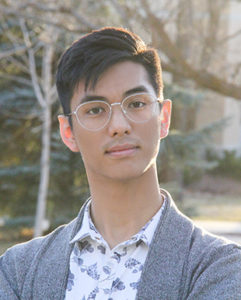 Undergraduate Takara Truong is the recipient of the Outstanding Undergraduate Research Award for the College of Engineering from the U’s Office of Undergraduate Research. Truong has also received the prestigious fellowship from the National Science Foundation’s (NSF) Graduate Research Fellowship Program (GRFP). Truong’s current research is developing Human-Robot Interaction (HRI) technologies. Truong is advised by Associate Professor Mark Minor and works with Professor Dave Carrier (Biology) and Professor John Hollerbach (Computer Science). Truong is part of the Robotic Systems Lab.
Undergraduate Takara Truong is the recipient of the Outstanding Undergraduate Research Award for the College of Engineering from the U’s Office of Undergraduate Research. Truong has also received the prestigious fellowship from the National Science Foundation’s (NSF) Graduate Research Fellowship Program (GRFP). Truong’s current research is developing Human-Robot Interaction (HRI) technologies. Truong is advised by Associate Professor Mark Minor and works with Professor Dave Carrier (Biology) and Professor John Hollerbach (Computer Science). Truong is part of the Robotic Systems Lab.
The Outstanding Undergraduate Researcher Award honors a student from every college. The award is based on commitment to developing research skills and knowledge, evidence of independent and critical thinking, active participation in research-related activities on campus, and positive contributions to the research culture of the department, college, and university.
The NSF Graduate Research Fellowship recruits high-potential, early career scientists and engineers and supports their graduate research training. The award provides three years of financial support within a five-year fellowship period, leading to a research-based master’s or doctoral degree in a STEM field.
The spark that ignited that interest in research came in 2011, when a youth outreach initiative gave him the opportunity to intern at the Robotics Systems Lab. “The sheer excitement I felt walking through the lab doors was matched only by my enjoyment in helping record experiments of a bi-pedal robot and solder components,” said Truong.
Truong continued his research pursuits, finding his way back to the Robotics Systems Lab and working with HRI technologies, including highly interdisciplinary projects spanning mechanical and electrical engineering, biology, and physical medicine and rehabilitation. The overarching focus of Human-Robotic interaction is the interactions between humans and robots and includes areas such as methods for perceiving humans, motion planning, learning, manipulation and many others. The goal of this research is generally to improve human-robot interactions and has applications in manufacturing, personal and assistive robotics, and rehabilitation.
As part of his research, Truong worked on a project to create a smart helmet to reduce the risk of traumatic brain injuries. As part of this, he created several HRI systems that involved virtual reality, a tether-based impactor, and helped develop and manufacture a smart football helmet. Additionally, he worked on HRI systems involving gait rehabilitation and the creation of a mechanical harness for patients.
“In the future, I envision a world where robots are fully integrated into home and industry,” said Truong. “These robots will have the intelligence to interpret tasks given by natural human commands and correctly work with humans or other robots to complete the task.”
To learn more about Truong and his research visit his website: www.takaratruong.com/.